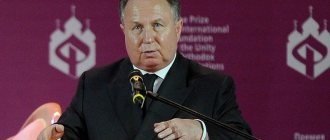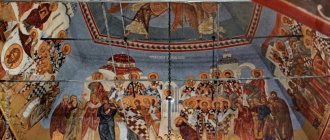The Constantinople Orthodox Church is called the Ecumenical Patriarchate in official sources. It has another, Greek name - the Great Church of Christ. In honor, it is the first Orthodox Church headed by a primate - the Patriarch. The location of its administrative center was the Istanbul Phanar.
Creation
There is a legend that the founder of the Church of Constantinople was Andrew the First-Called. The disciple Stachys ordained by him in about 38 became the bishop of the city of Byzantion. Here, in the first half of the 3rd century, Constantine the Great founded the new capital of the Roman Empire - Constantinople.
The Second Ecumenical Council of 381 adopted the third rule. It speaks of the second most honorable position of the Archbishop of Constantinople. The only person more important than him is the Pope. In the mid-5th century, at the Council of Chalcedon, the Ecumenical Church received its Patriarch, and the Church of Constantinople became a patriarchate. In the Vatican, for the first time, the bishop of Constantinople was recognized as second in rank by Pope Gregory the Great.
The Armenian Church asserted that Constantinople has the right to its bishops in foreign lands that are not part of its diocese. In 988, Patriarch Nicholas II of Constantinople Chrysoverg sent his representatives to Rus'. From them, Prince Vladimir of Kiev and the Russian people received baptism.
A. Includes all New Testament believers
There is only one church in the universe; thus, the church is universal and includes all believers in Christ from all times and from all corners of the earth (Eph. 1:22). The universal church includes all of God's redeemed saints of the New Testament age. Old Testament saints such as Abraham, Isaac, Jacob, Judah, Moses, David, and Isaiah were not members of the New Testament church. The New Testament church began with the outpouring of the Holy Spirit in Acts. John the Baptist was not in the New Testament church. The Lord Jesus said: “For I say to you, of those born of women there is not one prophet greater than John the Baptist; but he that is least in the kingdom of God is greater than he” (Luke 7:28). This shows that John was not a member of the New Testament church.
At His return the Lord Jesus will end the church age and many Jews will repent. In Zech. 12 we see the details of their salvation. The Jews will be saved, but they will not be in the New Testament church. We are the most blessed people, because we are in the most blessed age, the age of the church. The church has a universal aspect, which includes Peter, John, Paul and all believers throughout the ages. It includes us, it includes those who will follow us in the future.
Schism in Christianity and restoration of communion between Churches
In 1054, a great schism occurred, which led to the cessation of first church-canonical, and later eucharistic communion between Constantinople and the Vatican. Both Churches blamed the other side for the fact that the United Church split. In addition, Constantinople called the Pope a heretic.
In 1274, the Council of Lyon took place, where the Vatican and the Church of Constantinople entered into a union for the first time, which was repeated in the first half of the 15th century during the Ferraro-Florence Council. But the church people rejected both unions, which led to the re-establishment of the Patriarchate of Constantinople. In the mid-15th century, supporters of the union were expelled from their territory by the Ottoman Turks. Only the Patriarchate of Constantinople received recognition from them.
In 1862-1923. The patriarchy was governed by a Mixed Council, which included four bishops and eight laymen elected for a two-year term. At the same time, a multi-stage procedure for the election of the patriarch was introduced, which was based on the “General Statutes” of 1860.
Signs of Ecumenical Councils
| Christianity |
| Bible |
|
| Trinity |
|
| History of Christianity |
|
| Christian theology |
|
| Christian worship |
|
| Directions in Christianity |
basic
marginal
|
| Criticism of Christianity |
|
| Other |
|
| Portal:Christianity |
Ecumenical councils have external and internal distinctive features[3].
The external features of Ecumenical Councils include:
- participation in the council of representatives of all local churches in the person of heads of churches, bishops or their deputies, authorized and sent (legates) from them;
- canonical correctness in the order of convening the council, forming the composition of participants, conducting and announcing the decisions of the council;
- recognition of the Ecumenical Council by all local churches, both those from which bishops were present at it and those from which there were no representatives.
Internal features of Ecumenical Councils:
- the correspondence of its decrees with the Holy Scriptures, apostolic tradition, dogma and rules of the Universal Church of all previous centuries;
- the unanimous expression on it of the creed, which all local churches adhered to and adhere to everywhere and always;
- legislative activity characteristic of the church only to Ecumenical Councils (drawing up symbols of faith and expounding dogmas).
In resolving questions about the truths of doctrine and moral teaching, the Ecumenical Council has the property of infallibility, as an organ of the Universal Church, guided by the Holy Spirit. Dogmatic definitions and canons of the Ecumenical Councils are placed in the “Book of Rules”, definitions and judicial decisions - in the “Acts”.
Patriarchate of Constantinople in the 20th century
At the end of the 20s. In the 20th century, by decision of the Turkish government, all Asia Minor Orthodox metropolises were closed. The metropolitans had to settle in Greece or become powerless hierarchs in Constantinople. Patriarch Meletios was the first to say that the entire Orthodox diaspora belongs to the Patriarchate of Constantinople according to the canon. At the same time, he referred to several rules adopted at the Council of Chalcedon.
In 1964, Pope Paul VI and Patriarch Athenagoras met in the city of Jerusalem. A year later, the mutual anathemas were lifted and the Joint Declaration was signed. Today, Constantinople has under its jurisdiction a number of ecclesiastical areas in Crete and Athos, in Chalkidiki and other Greek dioceses. It also includes the Finnish Autonomous Church and many dioceses in different parts of the world.
In 1954, the Patriarchate of Constantinople suffered from a Muslim pogrom. A year later, the entire Greek community was subjected to repression in the city. In the mid-90s. In the 20th century, terrorists attempted and blew up Orthodox churches. In 1971, by decision of the Turkish government, the theological school in Halq was closed, and 27 years later its board of trustees was dissolved.
Understanding of “universality” in the Orthodox tradition
On February 25–26, 2021, a scientific and practical conference “Causes and challenges of the current crisis in inter-Orthodox relations” was held at PSTGU, during which Pavel Vladimirovich Kuzenkov, associate professor of the Faculty of History of Moscow State University, a teacher at Sretensky Theological Seminary, presented his report “The Universal Church in the Orthodox Tradition.” The report offers an analysis of the tradition of using the word “ecumenical”, which is included in the title of the Patriarch of Constantinople. As the speaker showed, the texts of the sources indicate that both in the time of the apostles and in the patristic era, the understanding of this term was completely different from what they are trying to present today. The “universe” (ecumene) meant the Roman Empire, and the concept “ecumenical” meant “national”. Moreover, all five patriarchates, the main departments of the empire, were called “ecumenical,” and not just the one of Constantinople. This tradition was also reflected in Russian practice in the 16th–17th centuries, when all-Russian councils were called “ecumenical.” Based on the analysis presented, the speaker pointed out the complete groundlessness of Constantinople’s claims to global jurisdiction, allegedly arising from its ancient title.
15th-century map depicting Ptolemy's description of the Ecumene (1482, engraving by Johann Schnitzer)
Recent events around the Orthodox Church have brought issues of Orthodox ecclesiology and canon law to the forefront not only of intra-church, but also of wider public discussion.
Now no one should doubt the fact that the policy of the Patriarchate of Constantinople to deform the historically established and established thousand-year-old Orthodox tradition of the church governance system is well-thought-out, and all actions in this direction - starting from the infamous Cretan Council of 2021 and ending with the unprecedented due to its canonical unprincipled interference in the affairs of the Moscow Patriarchate in Ukraine - carefully weighed and planned in advance.
In these conditions, it seems especially important to identify the genesis, development and internal content of the most important concepts and institutions for the Orthodox tradition, such as “Local Church”, “conciliarity”, “catholicity”, “primacy”, etc.
Below we will propose to trace the history of the formation and development of one of the key terms of the Orthodox ecclesiological tradition, namely, the concept of “ecumenical” (οἰκουμενικός).
1. Ecumenical = general imperial
The Greek word "oikoumene" (οἰκουμένη) literally means "inhabited [earth]" (from where the Slavic calque "universe" comes from). However, already in Antiquity, it was customary to use this word to refer to the area of distribution of Greek civilization - as opposed to the barbarian areas; and in Roman times, this term began to be understood in a political context - as a synonym for the Roman Empire[1].
For further reasoning, it is especially important that it is in this last meaning that the word “universe” is used in the New Testament, namely by the Apostle Luke in the Gospel and Acts (Luke 2: 1[2] and Acts 17: 6[3] ; 24, 5[4]). The broad meaning of understanding the “ecumene” as an empire was the use of this term by the Apostle Paul to designate the main hope of the Christian faith - the coming Kingdom of God (Heb. 2, 5[5]).
In the patristic era, the use of the word “ecumene” remained twofold: it could designate both the entire globe[6] and the Roman Empire[7]. The second option is typical for official texts that reflected the claims of emperors to the universalistic nature of their power.
2. Ecumenical Council - Council of Bishops of the Empire
First Council of Nicaea. Fresco, XVIII century. Bucharest Stavropol Monastery, Romania
The term “ecumenical” comes into ecclesiastical usage primarily as the name of the general Council of Bishops, first convened on the initiative of Emperor Constantine in the year 325 in Nicaea. It is significant that the geographical area of the participants in the Council of Nicea, which opened a series of similar church-wide congresses, was emphatically all-empire. It was convened by imperial decree as a meeting of the bishops of the empire to consider domestic church problems.
The prerogatives of imperial power in the sphere of the sacred can be derived from the pagan Roman legal tradition [8]: sacred affairs and the clergy belong to the sphere of public law, as the maxim from Ulpian’s Institutes, included by Justinian in the 1st book of the Digest, says. Since, according to the so-called Lex Regia of Vespasian, included in the same Digests, the emperor received from the people all the rights of supreme civil power, religious issues were also entrusted to his care. Of course, in the Christian era, the emperor's rights in this area were limited - after a very painful adaptation - to the public sphere and church canons. But the idea that the Ecumenical Councils were convened by civil authorities for purely civil purposes (concern for the unanimity of the people, public peace, the well-being of the state, victories of the army, etc.) runs like a red thread through the imperial decrees (sacrs) on the convening of bishops[9] .
The Ecumenical Council was never convened as the highest body of church government
Only later, as conciliar decisions were received in other Churches, outside the Roman Empire, could its status - like the status of subsequent Ecumenical Councils - be perceived as universally Christian. The procedure for making decisions at Ecumenical Councils is also very remarkable: thus, the Nicene decrees were adopted in the Persian Church of the East in 410 at the Council in Veh Ardashir, convened, characteristically, by Shahanshah Yazdegerd I. Thus, this Council is an analogue of the Ecumenical Council at territory of Sasanian Iran, with the characteristic difference that it was convened not by a catechumen Christian, but by a Zoroastrian.
The Ecumenical Council was never convened as the highest body of church government. His tasks were always extremely specific: refuting heretical false teachings and formulating dogmas, on the one hand, and solving pressing canonical issues, on the other.
It is important to note: although the Rules of the Ecumenical Councils are rightfully presented as the basis of the canonical tradition of Orthodoxy, the Ecumenical Council is neither the only nor a fundamentally special source of church law. The “Book of Rules” also includes authoritative definitions of the holy fathers, decisions of Local Councils, and interpretations of church canonists. Thus, the Ecumenical Councils only fit into the general broad circle of the Orthodox legal tradition, but by no means exhaust it.
The formulas in which the Ecumenical Councils refer to each other are fundamentally important: they do not speak about the decisions of the Councils as special church institutions, but about the decisions of the bishops who participated in them. This seemingly insignificant detail shows that conciliar decisions were perceived not in a formal institutional context, but as unanimous decisions of bishops united by like-mindedness in the Holy Spirit.
It should be especially noted that there are no dogmatic or canonical definitions about the status, nature and form of the Ecumenical Council. Moreover, in history there have been more than once Councils that convened and worked under the name of Ecumenical Councils, but were subsequently defined by church tradition as false councils, whose definitions were condemned as heretical. Because of this, the definition of the dogmatic decisions of the Ecumenical Councils as infallible turns out to be in a dialectical connection with the very definition of the Ecumenical Council as a Council, whose dogmatic decisions are recognized as Orthodox. In any case, it is not the Council itself that determines its Ecumenical character: this happens in the course of the subsequent reception of its decisions by the fullness of the Church.
Along with the spread of the term “Ecumenical Council” in the West, the concept of the “Universal Church” (lat. Ecclesia universalis) appears. At the same time, the popes, starting from the 5th century, strongly emphasize the secondary nature of any Councils, even Ecumenical Councils, in relation to the department of the Apostle Peter, which is “primary” in the Universal Church[10].
3. Ecumenical Thrones – pentarchy of the Patriarchates of the Empire
Map of Justinian's Pentarchy, with almost all of modern Greece under Rome. Emperor Leo III the Isaurian moved the border of the Patriarchate of Constantinople west and north in the 8th century. Source: wikipedia.org
In relation to the Primates of the episcopal thrones, the term “Ecumenical” begins to be used more than a century after the first Ecumenical Council. In 449, on
At the 2nd Ephesus (“Robber”) Council, Bishop Olympius of Evaz from the Ephesian Metropolis addressed Patriarch Dioscorus as the “Ecumenical Archbishop of the great city of Alexandria”[11]. The Church of Ephesus at this time tried - and not without success - with the help of Alexandria to defend its independence from Constantinople, so the appeal of Olympius can be considered deliberately magnificent. However, the very use of the term “Ecumenical” in this context clearly shows that even at that time its meaning was clear - and clearly indicated a certain special status of the bishop. Moreover, the status is not exceptional. In complaints against Dioscorus himself, addressed to Rome, the Alexandrian clerics Theodore, Ischirion and Athanasius call Pope Leo the Great “the most holy and blessed Ecumenical Archbishop and Patriarch of great Rome.”[12] Thus, in church politics of the 5th century, the title “Ecumenical” - still informally - indicated the special significance of the bishop, his church-wide authority. Obviously, such an understanding of the term “οἰκουμενικός” was possible only when correlating it with political usage in the sense of “general imperial”.
In the 6th century, the epithet “Ecumenical” appears in the title of the Patriarchs of Constantinople. It was first recorded in Justinian’s decree of 530, addressed to “Epiphanius, Archbishop of the Happy City and Ecumenical Patriarch”[13]. This legislative monument is also curious in that the department of Epiphanius is called in it “the most holy Great Church of this happy city, our and universal mother, who is the head of all others”[14].
However, these pompous phrases should not be misleading. Firstly, the title “Ecumenical” is used here not at all as an innovation, but rather as a routine ceremonial expression. Secondly, the supremacy of Constantinople was never conceived as absolute. Justinian himself recorded this in the law of 545 (131st novel), where it was established, in strict accordance with the decisions of the Second and Fourth Ecumenical Councils, that “The Most Holy Pope of Ancient Rome is the first of all priests, and the Most Blessed Archbishop of Constantinople, New Rome, occupies second degree after the most holy apostolic see of elder Rome, but is revered above all others.”[15]
But the most important document for a conceptual understanding of the system of church organization developed in Roman legislation under Justinian is the 109th novel of 541. It contains the following passage:
“They also called heretics, and we call those who belong to various heresies... and in general all who are not members of the holy Catholic and Apostolic Church of God, in which all the most holy Patriarchs of the entire universe - both Western Rome and this royal city, and Alexandria, and Teupol, and Jerusalem, and all the most reverend bishops subordinate to them, unanimously proclaim the apostolic faith and tradition”[16].
In fact, it is here that we have expressed expressis verbis the principle of church “universality”, which was repeatedly expressed in other forms both before and after Justinian. This principle organically unites the concepts of the Ecumenical Council and the five Ecumenical Patriarchal Thrones: the first is an extraordinary assembly, and in ordinary times its tasks - the condemnation of heresies and the proclamation of the apostolic faith and tradition - are carried out by the five senior bishops of the "universe", that is, the empire. The status of the members of such a pentarchy is precisely state, and not church, since, along with the five Patriarchs, there are other autocephalous Churches - for example, the Church of Cyprus or the department of Justiniana the First, established by Justinian himself. But these thrones, independent from the point of view of the canons, are included among the subordinates of the pentarchy in the state optics of “universality”. As for the Churches outside the Empire - in Iran, Georgia, Armenia, Ethiopia - their church organizations were never considered as included in the “ecumene”. The dogmatic unity of Christians was defined through the concept of “catholicity.”
The dogmatic unity of Christians was determined through the concept of “catholicity”
Relations between the Local Churches were characterized by differences in honor and equality in power. It was only due to historical conditions that the pentarchy system was largely deformed towards the See of Constantinople, which to this day enjoys the title “Ecumenical”. However, the traditional use of this title by the former capital of the former Empire should not obscure the fact that initially - and more than once subsequently - all five patriarchates were recognized as ecumenical, to which the fullness of Orthodoxy in the Empire was reduced in those days.
Thus, the famous writer and church leader of the early 9th century. St. Theophan the Confessor, close to the Patriarchal Office of Constantinople, in his “Chronography” calls all five patriarchates “great and universal thrones” (μεγάλοι καὶ οἰκουμενικοὶ θρόνοι)[17].
It is very important that such an understanding was preserved even after the fall of Byzantium in the Russian tradition. In the Charter of the Council of 1589 on the establishment of the patriarchate in Russia, the elevation to the patriarchal rank of Job of Moscow, performed by Patriarch Jeremiah II, is described as the election of “your most holy Jeremiah Archbishop of Kostiantinople, New Rome, and the Ecumenical Patriarch, and other Ecumenical Patriarchs, Alexander Yeisky, Antioch , Jerusalem and the entire Greek Council”[18].
In Russian monuments of the 16th–17th centuries one can often come across the expression “Ecumenical Council” in relation to the hierarchical Councils of the Russian Church[19].
4. Ecumenical claims of Constantinople
It should be emphasized that it is fundamentally impossible to distinguish at the terminological level the “all-imperial” and “worldwide” plans of the concept “Ecumenical” - which perfectly reflected the duality of the very status of the Roman state, which regularly declared itself as a universal superpower. Such duality seemed to be fertile ground for a shift in the meaning of the title “Ecumenical,” which in official documents was applied exclusively to the Archbishop of Constantinople-New Rome, towards claims of a truly universal nature of jurisdiction. However, we do not see anything like this in the sources.
Anastasius the Librarian, papal envoy to Constantinople at the Council of 869, wrote:
“The Greeks often called their Patriarch Ecumenical... When I, being in Constantinople, often condemned the Greeks for this word and reproached them for vanity and pride, they objected that this is not why they call the Patriarch Ecumenical (oecumenicus, which many translated with the word universalis), so that he would be a bishop over the whole world, but because he has superior authority over one part of the world in which Christians live. What the Greeks call the “universe” (οἰκουμένη), among the Latins means not only “world” (orbis), from the use of which in the sense of “universe” the name “universal” comes from, but also every dwelling or inhabited place.”[20 ].
Thus, in the 9th century, in contacts with Rome, the Byzantines themselves interpreted the title “Ecumenical” as “Local”, which organically follows from the traditional understanding of the word “οἰκουμενικός” as “general imperial”.
In contacts with Rome, the Byzantines themselves interpreted the title “Ecumenical” as “Local”
This understanding has persisted for centuries.
The District Epistle of the Church of Constantinople of 1895 literally says:
“The Divine Fathers, honoring the bishop of Rome only as the bishop of the reigning city of the empire, granted him the honorable privilege of chairmanship, looked upon him simply as the first among other bishops, that is, the first among equals, which privilege was later given to the bishop of the city of Constantinople, when this city became reigning in the Roman Empire... The Bishop of Rome is equal to the bishop of the Church of Constantinople and the bishops of other Churches, and in no rule or in any of the fathers is there even a hint that the Bishop of Rome is the sole head of the Catholic Church and the infallible judge of the bishops of other independent and autocephalous churches "[21].
The situation changes radically in the 20th century. At this turning point for the fate of all Eastern Christianity, Constantinople is trying to reformat the entire structure of world Orthodoxy and take the place in it, if not of the supreme head, then, in any case, of a “trustee” unique in its status of all other Local Churches.
If the official calendar of the Church of Constantinople for 1906 also states that the name “Ecumenical” was initially and always remained “only honorary, having nothing to do with the scope of the jurisdiction of the Ecumenical Patriarch”[22], then already in 1908 in the tomos of Joachim III we read the following:
“Neither the Church of Greece, nor any other Church or throne could, according to the canons, extend its power beyond the boundaries of its region, with the exception of our most holy apostolic and patriarchal Ecumenical Throne, rightly authorized to exercise the supreme spiritual care of foreign Churches as on the basis of the privilege granted to it to appoint bishops in the lands of foreigners, and therefore outside the established church areas, and on the basis of its advantages (πρεσβείων)”[23].
It is absolutely clear that by “the privilege of appointing bishops in the lands of foreigners” we mean the 28th canon of the Council of Chalcedon. However, this rule can only be understood in this way by a completely arbitrary, or rather, false interpretation. For this famous and at one time so controversial canon literally reads:
“...And so that only the metropolitans of the Pontic, Asian and Thracian dioceses, as well as the bishops of the above-mentioned dioceses among foreigners ειρημένωνδιοικήσεων) would be supplied by the above-mentioned most holy throne of the most holy Church of Constantinople”[24].
So, the Patriarch of Constantinople is indeed allowed to appoint foreign bishops. But only and precisely within three specific regions of the empire - the dioceses of Pontus, Asia and Thrace. And nothing else! This is confirmed both by the context of the rule (the Patriarch does not appoint the rest of the bishops: they are installed by their own metropolitans), and by all subsequent centuries-old church practice.
In 1919–1921, against the backdrop of euphoria after the collapse of the Ottoman Empire and the occupation of Constantinople by Entente troops, the idea of a “League of Churches” (Κοινωνία τῶν Ἐκκλησιῶν) was formulated in the Phanar. One of its ideologists, Chrysostom (Papadopoulos), wrote:
“The former Turkish tyrannical rule in Constantinople prevented any activity of the Ecumenical Patriarch, but now, in free Constantinople, the Patriarch will in any case take advantage of freedom of action not only in relation to his Church, but also to the rest of the Orthodox Churches and the League of Churches now being created. Moreover, the Patriarch could have with him representatives of all Orthodox Churches, invite their Primates and other bishops to Constantinople to consider and resolve church-wide issues relating to the entire Orthodox Church”[25].
Plans to turn Constantinople into an ecumenical center of world Christianity were not realized at that time. Then the “minimum program” was put into action: in the conditions of a sharp weakening of the Russian Church, to try to promote the Ecumenical Patriarch to the role of leader of world Orthodoxy.
In January 1923, at the peace conference in Lausanne, the head of the Greek delegation, E. Venizelos, stated that “the Ecumenical Patriarchate is primate for all Orthodox Churches. In this capacity, he deals with all the leaders of the autocephalous Orthodox Churches on all issues relating to faith, Christian morality and church law. In these matters, the views and authority of the Ecumenical Patriarchate are of decisive importance... The Archbishop of Constantinople - New Rome... was elevated to the dignity of the Ecumenical Patriarch by the decision of all Christian Churches, including the Roman Church. No one in the world can separate these two attributes.”[26]
It should be noted that such, to put it mildly, an expanded interpretation of the primacy of the honor of the throne of Constantinople had practical motives at that time: to exert moral pressure on the Kemalist delegation, which demanded the deportation of the Patriarch outside Turkey. Apparently for the same reason, the head of the Synod of Bishops of the ROCOR, Metropolitan Anthony (Khrapovitsky), in a letter to the president of the Lausanne Conference, carelessly allowed himself to call the Patriarch of Constantinople “the supreme judge for Orthodox Christians of all countries”[27].
But the Phanar tried to consolidate this momentary situation by announcing the preparation of a pan-Orthodox Ecumenical Council. This Council was scheduled by the so-called “Pan-Orthodox Congress” of 1923 of 9 people led by Meletios (Metaxakis) and scheduled for Pentecost 1925 in Jerusalem by an act of Patriarch Gregory VII (Zervoudakis) of May 27, 1924. It is very characteristic that 11 days earlier, on May 6, the same Gregory VII, together with his Synod, called on St. Tikhon to leave the throne and abolish “at least temporarily” the patriarchate in Russia, and soon he actually recognized the Renovationist Synod[28].
Already in November, Gregory VII died, and Constantine VI, elected in his place, was deported by the Turks. In this situation, the Ecumenical Council had to be forgotten.
It should be recognized that even in this atmosphere of intrigue against the Russian Church in Constantinople in those years, they still retained quite sound ecclesiological ideas, reflected in the official statement of June 20, 1924:
“According to the sacred Canons of the Orthodox Eastern Church, every Orthodox Patriarchate, such as: Constantinople, Alexandria, Antioch, Jerusalem, Russian and Serbian, and every Autocephalous Orthodox Church ... can exercise its spiritual power only within its natural borders and cannot perform acts outside them no religious or spiritual activities. Church decrees on this issue are unambiguous and do not allow for discussion.”[29]
It is not possible here to list all the stages of transformation of Constantinople ecclesiology in the second half of the 20th century and the beginning of the 19th century.
We will indicate only two of the most characteristic episodes.
On September 24, 2008, speaking at the plenary assembly of the European Parliament, Patriarch Bartholomew stated: “Being a purely spiritual institution, our Ecumenical Patriarchate embraces a truly global apostolic ministry, which seeks to elevate and expand the consciousness of the human family, in order to understand that we all live in one house. This is, in its fundamental sense, the meaning of the word “Ecumenical”—for “oikoumene” is the inhabited world, the Earth, understood as the house in which all peoples, tribes, tribes and languages live.” And further:
“As you well know, our Patriarchate is not a “national” Church, but rather the fundamental canonical expression of the universal dimension of the gospel message and its analogous responsibility in church life. This is the deeper reason why the Church Fathers and Councils gave it the name “Ecumenical”. The loving care of the Church of Constantinople transcends any linguistic, cultural, ethnic and even religious definition, as She strives to serve all peoples.”[30]
At the beginning of 2014, in response to the statement of the Moscow Patriarchate on the issue of primacy in the Church, a polemical text by Metropolitan Prusa Elpidophoros (Lambriniadis) appeared under the title “Primus sine paribus”. In it, a professor of theology at the University of Thessalonica, having carried out an extremely dubious from a dogmatic point of view interpretation of church primacy through the prism of triadology, formulated the thesis:
“The source of primacy in the Universal Church is the same Archbishop of Constantinople, who as a bishop is the first “among equals,” but as the Archbishop of Constantinople is the first hierarch without equals”[31].
It should be recognized that it is precisely these convictions, which were not formed and declared publicly yesterday, that underlie all the actions of Constantinople in the present and near future.
conclusions
As we see, the concept of the Universal Church is of key importance in the modern discussion, by which every modern Orthodox person understands the fullness of world Orthodoxy.
From the above sources, relating both to the period of the first centuries of Christianity and to the recent past, it is definitely clear that the Orthodox church-canonical tradition has never considered the epithet “Ecumenical” in the title of the Bishop of Constantinople or any other bishop as an indication of his universal jurisdiction.
The word "universe", since the New Testament, has usually been interpreted as a reference to the Roman Empire. Accordingly, the epithet “Ecumenical” was understood as “all-imperial”. This is precisely the meaning that was originally attached to the names of the Ecumenical Councils and the five Ecumenical Patriarchal Thrones.
It is important to clearly and clearly state: the ancient title “Ecumenical Patriarch”, used in our time in relation to the Archbishop of Constantinople, has no relation to the modern concept of “ecumenical” in the meaning of “worldwide”. It is nothing more than a reminder of New Rome's ancient status as the capital of a once thriving political "universe" - the Eastern Roman, or Byzantine, Empire. After its fall, the term “Ecumenical” was used to refer to the Councils of the new stronghold of world Orthodoxy - the Russian state, which, however, did not cause any attempts at world domination on the part of the Russian Church.
As for the universalism of the Holy Apostolic Church of Christ, from ancient times it was expressed not through the inherently geographical category of “universality,” but through the concepts of unity, universality and integrity, which are encompassed by the Greek term “καθολική.”
Structure and dioceses
The Patriarchate of Constantinople has a complex structure, covering all the inhabited continents of the world, with the exception of Africa, which the Patriarchate of Alexandria took under its wing. The Estonian and Finnish churches have autonomy, while the Archdiocese of Crete has semi-autonomy.
Türkiye contains 10 dioceses on its territory:
- Metropolis of Silivria;
- Metropolis of Smyrna;
- Prussian Metropolitanate;
- Pisidian Metropolis;
- Metropolis of Derk;
- Prinkiponis Metropolitanate, located on the Princes' Islands;
- Metropolises of Teneda and Imvres;
- Metropolis of Chalcedon in the Asian part of the Turkish Republic;
- Metropolis of Adrianople in Edirne;
- Archdiocese of Constantinople in Istanbul and the surrounding area.
In the early 20s of the 20th century, the creation of a unified Greek archdiocese of North and South America took place, which was first ruled by the Greek and then the Church of Constantinople. In the mid-90s, the metropolises left it:
- South American;
- Central American;
- Mexican;
- Canadian.
The American Archdiocese was left with only parishes in the United States of America.
In the early 30s. The establishment of the Western European Exarchate of the Russian tradition took place. Metropolitan Eulogius received from Photius II a letter of acceptance of the Russian Orthodox churches of Europe into the Patriarchate of Constantinople on the rights of a temporary exarchate, which was abolished in 2021.
Local churches
Main article: Local church
Autocephalous churches
The existing order of precedence of honor (the official order in the diptych) of local churches arose after the Great Schism: the first place in honor of the Roman see ( primus inter pares
) passed to the throne of the Patriarchs of Constantinople. In the 2nd millennium, a number of new autocephalous churches arose, following the Patriarchate of Jerusalem in diptychs. Since the beginning of 2021, there are 14 autocephalous churches and two whose autocephalous status is not recognized by all churches.
| Diptych of the Patriarchate of Constantinople[47] | Diptych of the Moscow Patriarchate[comm 2] |
| Autocephalous churches: | |
|
|
On September 14, 2021, the Russian Orthodox Church excluded the Patriarchate of Constantinople from the diptych, declaring its anti-canonical actions aimed at creating the Orthodox Church of Ukraine (OCU)[48][49][50][comm 3]; in response to the recognition of the OCU - the Church of Greece (November 3, 2021)[51][comm 4], the Church of Alexandria (November 8, 2021)[52][comm 5] and the Church of Cyprus (November 20, 2020)[comm 6].
The Orthodox Church in America in autocephalous status is recognized by the Moscow Patriarchate, the Bulgarian, Georgian, Polish and Czechoslovak churches, but is considered by the Patriarchate of Constantinople as part of the Russian Church[53]. Since 1965, the Cretan Orthodox Church has had semi-autonomous status within the Patriarchate of Constantinople.
The Orthodox Church of Ukraine (OCU) is recognized by the Patriarchate of Constantinople, which granted it autocephaly on January 5, 2019, by the Patriarchate of Alexandria, and the Churches of Cyprus and Greece. The Russian and Serbian[54] churches declared their non-recognition of the OCU as an Orthodox Church in any status. The remaining churches, as of December 2021, have not expressed their official positions regarding recognition or fundamental non-recognition (refusal to recognize) of the OCU - both with regard to the status of autocephaly and with regard to the legitimacy of the church.
Autonomous churches
- Sinai under the jurisdiction of the Jerusalem Church
- Finnish under the jurisdiction of the Church of Constantinople
- Estonian (apostolic) under the jurisdiction of the Church of Constantinople[comm 7]
- Japanese in the jurisdiction of the Russian Church[comm 8]
- Chinese in the jurisdiction of the Russian Church [virtually does not function]
[comm 9]
Patriarchate of Constantinople and the Russian Church
In 1993, Bartholomew I visited the Russian Federation and visited St. Isaac's Cathedral, where he met with Alexy II. In the speech of the Moscow Patriarchate, words were spoken about the tense relations between the two Orthodox Churches, the reason for which was a long dispute that began in 1872, when the Patriarchate of Constantinople condemned the Ottoman Porte, which created the Bulgarian Exarchate. The Holy Synod of the Russian Orthodox Church and the Emperor of Russia received a proposal from Constantinople that it was necessary to convene an Ecumenical Council to resolve the Bulgarian issue, but they rejected it. In the 20s of the 20th century, there was an aggravation in relations between the churches, which continues to this day. There are disagreements between Moscow and Constantinople on canonical and jurisdictional issues.
Content
- 1 Signs of Ecumenical Councils
- 2 Ecumenical councils and local churches
- 3 List of councils 3.1 Ecumenical councils recognized by the Orthodox, Catholic, Protestant and Ancient Eastern churches
- 3.2 Ecumenical councils recognized by the Orthodox, Catholic and Protestant churches
- 3.3 Ecumenical Councils recognized by the Orthodox and Catholic Churches
- 3.4 Councils called Ecumenical by some theologians and hierarchs of the Orthodox Church
- 3.5 Councils recognized only by the Catholic Church
- 3.6 Robber Cathedrals
Breakdown of relations due to Ukraine
In 2021, Patriarch Bartholomew made accusations against Moscow that the Russian Orthodox Church has not been interfering in the activities of the Kyiv metropolis over the past six centuries, outside the canon. In the 16th century, the Kyiv See was transferred to Moscow jurisdiction, to which the Ecumenical Patriarchate did not give its permission. Bartholomew undertook to solve this “problem”. According to Patriarch Kirill, the transfer of the see by Metropolitan Peter of Kyiv to Vladimir occurred after the Gentiles captured Kyiv, and subsequently Moscow accepted it into its jurisdiction, since this was “Divine Providence.”
The statement adopted by the Russian Orthodox Church at the Holy Synod spoke of “outrage” at the actions of the Patriarch of Constantinople, who sent his exarchs to Ukraine. After this, the Russian Orthodox Church temporarily stopped remembering Bartholomew in prayers at services. Joint services with his representatives were also suspended. In 2018, the Ecumenical Patriarchate restored its stauropegy in Ukraine.
Choose an answer
Notes
- Catholicism: An Atheist's Dictionary / General. ed. L. N. Velikovich. - M.: Politizdat, 1991. - P. 251. - ISBN 5-250-00779-1.
- Bulgakov S.V.
Ecumenical Councils. Councils of the Eastern Church in the 9th century. // Handbook for a clergyman. — 3rd ed. - K., 1913. - P. 1745. (inaccessible link) - Ecumenical Councils // Christianity. Encyclopedic dictionary in 3 volumes. Ch. edited by S.S. Averintsev. - 1993, M. - T. 1. - P. 385-386. — ISSN 5-85270-050-9.
- Posnov M.E.
“History of the Christian Church”, pp. 423-431. - ↑ 1 2 3 4 5 6 7
Ecumenical Councils (Russian).
azbyka.ru
. Date accessed: July 22, 2021. - The Pan-Orthodox Council was in jeopardy // Vzglyad, 8/VI/2016
- There is a mention of “the so-called eighth Ecumenical Council”, for example, in the “District Epistle” of 1848, § 5 paragraph 11: “Anathema, as an innovation and increase in the Symbol, at the (so- called) eighth Ecumenical Council
convened in Constantinople for the pacification of the Eastern and Western Churches." - Kapterev N. F.
Tsar and Moscow church councils of the 16th and 17th centuries Archival copy dated June 18, 2010 on the Wayback Machine // Theological Bulletin, 1906. - T. 3. - No. 10. - P. 331.











